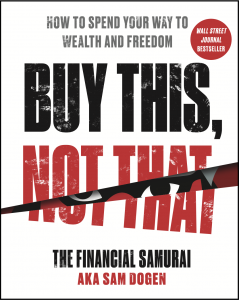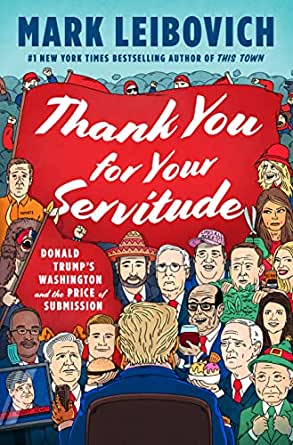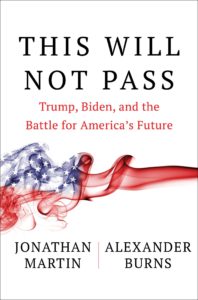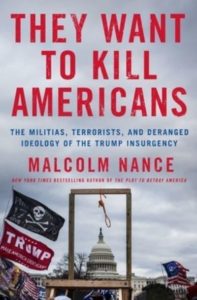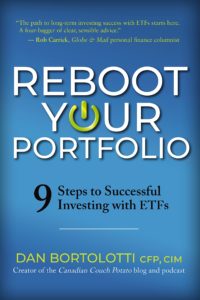Special to the Financial Independence Hub
Let’s face it, saving and investing should be simple.
- Save, automate your savings to buy stocks.
- Invest in stocks and/or low-cost products that invest in stocks to avoid mutual fund salespeople.
- Disaster-proof your life by having some cash stashed.
- Rinse and repeat.
But simple is not easy.
All too often, we humans love to make things far more complex than things need to be.
We’re wired that way unfortunately. Egos often get in the way.
Given many people continue to struggle with personal finance, every day, there are tens of thousands of books published out there on this subject – building and maintaining a responsible investment portfolio is only part of the personal finance success equation…
Learn why you should Buy This, Not That
Sam Dogen (aka Financial Samurai) knows a thing or two about personal finance success.
Sam founded FinancialSamurai.com in July 2009 during the depths of the global financial crisis.
Sam’s goal through that site was to deliver and share a cathartic way to make sense of the chaos at the time. Fast forward to today, more than 90 million people have visited Financial Samurai, and tens of millions more have read his work on publications such as CNBC, Yahoo Finance, and Business Insider.
Sam was previously at Goldman Sachs and Credit Suisse for 13 years – but he’ll share more details below!
When Sam is not writing or playing with his kids, you can find him on a tennis court or softball field in San Francisco, or on My Own Advisor giving away a book!
Sam is a graduate of The College of William & Mary and received his MBA from UC Berkeley.
I got a chance to chat with Sam recently about his new book: Buy This, Not That – How to Spend Money Your Way to Wealth and Freedom.
Here is our interview below before Sam:
Sam, welcome to the site – I know you’ve left a few comments over the years and nice to see you back!
Sam, maybe not everyone is aware of your financial journey and Financial Samurai beginnings. Can you share a bit of your bio with my readers? Where do you live, what have you invested in, and “how did you get here” to writing this book?
Sure thing, Mark.
I grew up in The Philippines, Zambia, Japan, Taiwan, and Malaysia before coming to America for high school and college at William & Mary. My parents were in the U.S. foreign service.
After college, I joined Goldman Sachs in NYC in their international equities department. It was a dream job, except for the fact I had to get in at 5:30 am and often leave after 7 pm! As a result, I decided to save and invest 50% of my after-tax paycheck so I could one day have options to escape.
In July 2009, I started Financial Samurai and helped kickstart the modern-day FIRE movement. It’s been great to see so many people embrace their financial independence journey since then. My definition of financial independence is having enough passive investment income to pay for your basic living expenses.
I decided to write Buy This, Not That because I felt it had to be written. When I started Financial Samurai, there weren’t a lot of personal finance bloggers with finance backgrounds. I noticed when I first got my book offer in early 2020, there weren’t many finance authors with finance backgrounds either! So, I decided to fill this hole and provide my perspective.
Instead of scratching the surface, I decided to go deep into many financial topics. I then tackled some of life’s biggest dilemmas many of us all face.

Great stuff.
Sam, in your book, you wrote:
“My first hope with Buy This, Not That is to help you let go of the fear of making a wrong financial choice. Let that sink in: there are no wrong money choices, just as there are no perfect choices, only optimal or suboptimal.”
Talk to me about your investing and wealth-building journey. What mistakes did you make? What successes did you have? What did this teach you and what do you hope to pass along to others in the book?
Mark, I made the suboptimal choice of buying a vacation property I didn’t need in 2007. I got it for 15% off, but it ended up declining by another 40% during the financial crisis! Luckily, most of its value has recovered and I’ve been taking my kids there since 2018.
Not extrapolating my income into the future was my biggest lesson learned. I was paid very well in 2007 and thought my income was just going to go higher. Life is full of ups and downs. Therefore, please be conservative with your income and return forecasts.
One of the key takeaways from the book is to encourage readers to think in probabilities, not absolutes. Don’t think you need 100% certainty to make a choice. Otherwise, you’re going to miss out on a lot of great opportunities.
In The Psychology of Money, Morgan Housel wrote effectively:
You don’t have to be a perfect investor. Getting wealthy and staying wealthy is “about consistently not screwing up.”
I agree with this/have always agreed with this and this aligns nicely to your 70/30 decision making philosophy. Can you explain that for readers and why is that framework so important to you to convey in the book when it comes to investing and wealth-building?
Use my 70-30 decision-making framework to build wealth and make more optimal choices. The framework states that if you believe there’s a 70% probability or greater your choice is the correct one, go for it, while having the humility knowing that 30% of the time, you’re going to get it wrong. And when you do, you will learn from your mistakes and get better.
Once you start approaching everything with a probability matrix in mind, you’re going to gain a tremendous competitive advantage compared to those who don’t.
I like that.
Sam, I personally equate the definition of Financial Independence (FI) as your investments generate enough passive income to cover your day to day living expenses. I’m not into this Barista FIRE, etc. What’s your take? Agree? Disagree? Why?
Yes, since 2009, I’ve stated that being financially independent means having enough investment income to cover your basic living expenses. However, I think Barista FIRE is a reasonable stop gap where you can earn extra income and receive subsidized health care while working a traditionally lower-wage job.
But at the end of the day, don’t fool yourself. If you still need to work, then you are probably not financially independent.
When I left work in 2012 at age 34, I had about $80,000 a year in passive investment income. I knew I wouldn’t starve, but I also wasn’t 100% confident I was doing the right thing. Therefore, I had my wife, who is three years younger than me, keep on working until age 34. If everything worked out with my new adventure, she could join me. In 2015, she was also able to negotiate a nice severance and hasn’t been back to work since.
So, when did you realize FI (Financial Independence)?
In 2012 when I was 34. At the time, I had a net worth of about $3 million that generated about $80,000 a year in passive income. But the biggest catalyst was negotiating a severance that paid for 5-6 years’ worth of regular living expenses. My severance paid all my deferred cash and stock compensation over the next three years. I also had a private investment made in 2010 that wouldn’t come due until 2017 that was fully paid out. Continue Reading…

